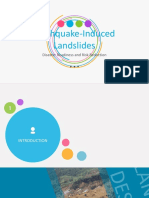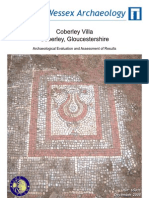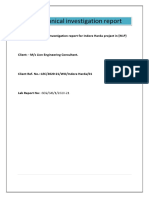Stochastic Modeling and Geostatistics - Principles, Methods, and Case Studies
Uploaded by
Ali ChouayaStochastic Modeling and Geostatistics - Principles, Methods, and Case Studies
Uploaded by
Ali ChouayaBook reviews
minerals which could have been drawn upon from existing an expensive collection of rather dated course notes rather
publications. I also would question the benefit of compiling than an insight into a fundamental and challenging area of
photographs into a separate section at the end of the book, subsurface technology. Alas, the niche remains unfilled; maybe
apart from the main text. next time!
Overall, I found the book to be very disappointing, par-
ticularly in view of its high cost. I could not recommend it as a Mike Bowman
reference text for either the practising or aspiring petroleum Technology Leader Reservoir Description
sedimentologist. I was left with the impression that the book is BP Exploration, Uxbridge, UK
Stochastic Modeling and Geostatistics: Principles, Methods,
and Case Studies
Edited by J. M. Yarrus and R. L. Chambers
AAPG Computer Applications in Geology, No. 3, 1994; American Association of Petroleum Geologists;
ISBN 0-89181-702-6 380 pp. Price: $149 (hardback). (AAPG members $99)
The continuing need to maximise hydrocarbon recovery from (by Journel and Coburn) giving personal perspectives, both
existing accumulations, combined with the rapid growth in academic and industrial, on the recent upsurge in geostatistics
computer technology over the past 10 years or so, has within the petroleum industry ('executive overviews'). The
challenged the traditional relationship between geoscientists first meaty section, Principles, contains four chapters covering
and petroleum engineers. Arguably one of the most important just a few, but by no means all of the fundamentals, including
benefits of this has been a wider appreciation of a field's three quite detailed and jargon-laden chapters on spatial
reservoir geology in controlling fluid flow and ultimate recov- modeling and semivariograms (Olea), sample support in per-
ery (e.g. structural framework, internal reservoir architecture meability assessment (Anguy et al.) and vertical facies varia-
and distribution of rock properties and heterogeneities). bility measures (Doveton). This section is completed by
Hence, the multi-disciplinary team is the now the norm another readable personal perspective, this time covering the
within most oil company production departments and field critical subject of upscaling from detailed geological descrip-
development units. This new working environment has not tion into numerical grids for fluid flow simulation (Mansoori).
always gone smoothly for everyone, partly since it has chal- Almost three-quarters of the book (17 of the 25 chapters)
lenged many traditional approaches to reservoir description, is contained within the section Methods and Case Studies,
not least the desire of most petroleum engineers to have a which comprises the application of geostatistical and stoch-
better appreciation of the uncertainties associated with geo- astic techniques to the quantification of various subsurface
logical interpretations or, to repeat the Editor's paraphrasing situations, including (1) three-dimensional reservoir descrip-
of Professor Andr6 Journel (Stanford University), "... it is tion and prediction ranging from fluvial (Tyler et al., Hatloy),
preferable to have a model of uncertainty than an illusion of shoreface (MacDonald and Aasen), deltaic (Bashore et al.)
reality." Enter the subject of geostatistics which, since its and aeolian (Cox et al.) sandstones, through to shelf-shoreline
introduction to reservoir geology in the mid-late 1980s, has carbonates (Chu et al.) and chalk deposits (Almeida and
become an integral part of reservoir characterisation. The Frykman), (2) integration of well and seismic data, including
days of the often frustrating two-handed geologist's traditional 3D seismic, and volumetric predictions (Chambers et al.,
reply to a reservoir engineer "on the one hand this reservoir Wolf et al., Hoye et al.), (3) fractal methods for reservoir
could be a..., but on the other hand...", are numbered. This characterisation (Hewett), and (4) impact of geological het-
book sets out to explain how and why geostatistics is so erogeneities, rock properties and permeability distribution on
important to all involved in subsurface geological description fluid flow prediction (Hohn and McDowell, Deutsch and
and prediction. Journel, Kelkar and Shibli, Murray). Many of these papers
Stochastic Modelin 9 and Geostatistics is a state-of-the-art support the earlier-stated benefits of multi-disciplinary studies
review, which represents a real landmark volume for what is and the value of being able to quantify uncertainties, but
one of the most rapidly expanding subjects within petroleum without losing sight of the basic underlying geological control.
geoscience. The book is comprehensive in its coverage, with A particularly good example of this is the paper by Bashore
contributions from many of the leading lights in geostatistics et al., who integrate geology, geophysics and reservoir engin-
and its petroleum applications. The Introduction (Srivastava) eering concepts and data, and then use stochastic models to
captures the background and recent developments in stoch- fully evaluate three different geological framework scenarios
astic methods for reservoir characterization. In a highly to consider the implications on fluid flow and hydrocarbon
readable contribution, the wide range of stochastic techniques recovery. There are many other excellent papers here which
are critically described, including both advantages and dis- can be used by the reader to observe how and why certain
advantages. The main body of the book is then divided into techniques were used. This section of the book also contains
four main sections: I Getting Started, II Principles, III copious use of colour, which not only improves the under-
Methods and Case Studies, and IV Public Domain Software standing of the subject matter (e.g. stochastic distribution of
and Bibliography. reservoir bodies and their internal rock properties) but also
The first section, Getting Started, should really be con- enhances the aesthetic appeal of the book.
sidered as part of the Introduction, with two short chapters The final section of the book, Public Domain Software and
Marine and Petroleum Geology 1996 Volume 13 Number 7 859
Book reviews
Bibliography, includes two very valuable contributions, one those involved in advanced (postgraduate and professional)
covering public domain geostatistical programs (all from the petroleum geoscience and engineering teaching. The latter
USA, but with costs, lists of addresses and telephone/fax group will find the case studies of particular interest since
numbers) (Clayton), and the other a carefully selected reading they nicely combine theory with practice. The quality of this
list to help the interested but inexperienced user to delve book is excellent in all respects and, given the wide use of
deeper into the subject (Yarus). colour illustrations, is not unreasonably priced at $149 ($99 for
This book fills an important gap in the literature and is AAPG members). I would certainly recommend individuals to
really packed tight with lots of information, which will be of dig into their personal pockets in order to have ready access
benefit to a wide audience, both experienced and inexperienced to this book, since the continued growth in this subject will
users of geostatistics. The very first statement in the book is make it a sound investment.
to reassure those less mathematically capable that this book
is aimed at a broad and mainly geological audience, and Howard D. Johnson
advanced mathematical knowledge is not a prerequisite for Department of Geology,
reading this book. This should not only help broaden its Imperial College of Science,
readership but, ultimately, its real usage. The most likely
users of the book are petroleum geologists, geophysicists and Technology and Medicine,
petroleum engineers, particularly those involved in multi- Prince Consort Road,
disciplinary field appraisal, development and reservoir man- London SW7 2BP, UK.
agement teams, research geoscientists and engineers (aca- Tel: 0171-594-6450. Fax: 0171-594-6464.
demic, government and industrial research laboratories) and E-mail: h.d.johnson@ic.ac.uk
860 Marine and Petroleum Geology 1996 Volume 13 Number 7
You might also like
- Waves in Ocean Engineering M.J. Tucker Ellis Horwood, Chichester, 1991, 431 Pages, IsBN 0-13-932955 2 1992No ratings yetWaves in Ocean Engineering M.J. Tucker Ellis Horwood, Chichester, 1991, 431 Pages, IsBN 0-13-932955 2 19921 page
- Goodman R E - Introduction To Rock Mechanics 2nd Edition100% (5)Goodman R E - Introduction To Rock Mechanics 2nd Edition289 pages
- Foreword 2021 Machine Learning and Data Science in The Oil and Gas IndustryNo ratings yetForeword 2021 Machine Learning and Data Science in The Oil and Gas Industry3 pages
- Marine Clastic Reservoir Examples and Analogues (Cant 1993) PDF100% (1)Marine Clastic Reservoir Examples and Analogues (Cant 1993) PDF321 pages
- Fluvial Depositional Systems 2014 - Andrew Miall PDF100% (6)Fluvial Depositional Systems 2014 - Andrew Miall PDF322 pages
- Rock Mass Strength Estimate - Chuquicamata Case StudyNo ratings yetRock Mass Strength Estimate - Chuquicamata Case Study9 pages
- Energy Resources" Geology, Supply and Demand: G. C. Brown and E. SkipseyNo ratings yetEnergy Resources" Geology, Supply and Demand: G. C. Brown and E. Skipsey2 pages
- Foreword and Introdu - 2012 - Regional Geology and Tectonics Principles of GeolNo ratings yetForeword and Introdu - 2012 - Regional Geology and Tectonics Principles of Geol3 pages
- A_Practical_Guide_to_Fluid_Inclusion_StudiesNo ratings yetA_Practical_Guide_to_Fluid_Inclusion_Studies3 pages
- Four Dimensional Analysis of Geological Maps: Techniques of InterpretationNo ratings yetFour Dimensional Analysis of Geological Maps: Techniques of Interpretation2 pages
- Principles_of_sedimentology_and_stratigrNo ratings yetPrinciples_of_sedimentology_and_stratigr2 pages
- A Practical Guide To Fluid Inclusion Studies: Mineralogical Magazine June 19860% (1)A Practical Guide To Fluid Inclusion Studies: Mineralogical Magazine June 19863 pages
- Marco G. Malusà, Paul G. Fitzgerald - Fission-Track Thermochronology and Its Application To Geology (2019, Springer International Publishing) - LiNo ratings yetMarco G. Malusà, Paul G. Fitzgerald - Fission-Track Thermochronology and Its Application To Geology (2019, Springer International Publishing) - Li395 pages
- A Practical Guide To The Study of Glacial Sediments: Boreas Book Reviews Boreas, Vol. 34, Pp. 232, Oslo 2005 (May)No ratings yetA Practical Guide To The Study of Glacial Sediments: Boreas Book Reviews Boreas, Vol. 34, Pp. 232, Oslo 2005 (May)1 page
- Book Reviews: Pergamoo 0146-6380 (95) Ooo79-2?No ratings yetBook Reviews: Pergamoo 0146-6380 (95) Ooo79-2?2 pages
- Golf-Racht, T. D. Van. - Fundamentals of Fractured Reservoir Engineering67% (3)Golf-Racht, T. D. Van. - Fundamentals of Fractured Reservoir Engineering729 pages
- (Rybach, L., Dan L.G.P. Muffler Dalam Arif Ismul Hadi, Refrizon 2005) .No ratings yet(Rybach, L., Dan L.G.P. Muffler Dalam Arif Ismul Hadi, Refrizon 2005) .2 pages
- Hydraulics in Civil and Environmental enNo ratings yetHydraulics in Civil and Environmental en2 pages
- Geological Journal - June 1993 - Gillespie - Fractals and Chaos in Geology and Geophysics by Donald L Turcotte CambridgeNo ratings yetGeological Journal - June 1993 - Gillespie - Fractals and Chaos in Geology and Geophysics by Donald L Turcotte Cambridge2 pages
- Fluid — Mineral Equilibria in Hydrothermal Systems_ by R. W. Henley, A. H. Truesdell, P. B. Barton Jr. an.... Reviews in Economic Geology, Vol. 1, Society of Economic Geologists, 267 Pp, $15 (Geothermics, Vol. 14, Issue 1) (1985)No ratings yetFluid — Mineral Equilibria in Hydrothermal Systems_ by R. W. Henley, A. H. Truesdell, P. B. Barton Jr. an.... Reviews in Economic Geology, Vol. 1, Society of Economic Geologists, 267 Pp, $15 (Geothermics, Vol. 14, Issue 1) (1985)2 pages
- Hydraulics in Civil and Environmental EngineeringNo ratings yetHydraulics in Civil and Environmental Engineering3 pages
- Geologisches Landesamt NRW, Krefeld, Germany: Book ReviewsNo ratings yetGeologisches Landesamt NRW, Krefeld, Germany: Book Reviews3 pages
- 1956-Chayes. - Petrographic Modal AnalysisNo ratings yet1956-Chayes. - Petrographic Modal Analysis120 pages
- The Application of Outcrop Analogues in Geological ModellingNo ratings yetThe Application of Outcrop Analogues in Geological Modelling25 pages
- Geological Applications of Wireline LogsNo ratings yetGeological Applications of Wireline Logs28 pages
- (NaftAcademy - Com) Fundamentals of Fractured Reservoir Engineering - Van Golf100% (1)(NaftAcademy - Com) Fundamentals of Fractured Reservoir Engineering - Van Golf729 pages
- Using Geochemical Data: Evolution, Presentation, InterpretationNo ratings yetUsing Geochemical Data: Evolution, Presentation, Interpretation2 pages
- Prospeccion Geoelectrica en Corriente ContinuaNo ratings yetProspeccion Geoelectrica en Corriente Continua2 pages
- (Handbook of Exploration Geochemistry 1) W.K. FLETCHER (Eds.) - Analytical Methods in Geochemical Prospecting-Elsevier Science LTD (1981) PDF100% (1)(Handbook of Exploration Geochemistry 1) W.K. FLETCHER (Eds.) - Analytical Methods in Geochemical Prospecting-Elsevier Science LTD (1981) PDF255 pages
- Of Fluvial Sedimentology, and I Believe That,: Book ReviewsNo ratings yetOf Fluvial Sedimentology, and I Believe That,: Book Reviews2 pages
- Book Reviews: Journal of The American Water Resources AssociationNo ratings yetBook Reviews: Journal of The American Water Resources Association5 pages
- Foreword: " Ces Millions de Grains Et La Variété Inépuisable de Leurs Formes Et de Leurs Dimensions ."No ratings yetForeword: " Ces Millions de Grains Et La Variété Inépuisable de Leurs Formes Et de Leurs Dimensions ."3 pages
- Cso202 Atomic and Molecular Beam MethodsNo ratings yetCso202 Atomic and Molecular Beam Methods2 pages
- 1989 Goodman IntroductionRockMechanics 2edNo ratings yet1989 Goodman IntroductionRockMechanics 2ed563 pages
- 2 Depositional Environments As Interpreted From Primary Sedimentary and Stratigraphic SequencesNo ratings yet2 Depositional Environments As Interpreted From Primary Sedimentary and Stratigraphic Sequences158 pages
- Earth Science 14th Edition Tarbuck Solutions Manual pdf download100% (1)Earth Science 14th Edition Tarbuck Solutions Manual pdf download45 pages
- Nearshore Dynamics and Coastal Processes Theory, Measurement, and Predictive Models by Kiyoshi Horikawa0% (1)Nearshore Dynamics and Coastal Processes Theory, Measurement, and Predictive Models by Kiyoshi Horikawa2 pages
- Laterites. Concepts, Geology, Morphology and Chemistry: Clay Minerals January 1996No ratings yetLaterites. Concepts, Geology, Morphology and Chemistry: Clay Minerals January 19963 pages
- Mineralogy For Metallurgists: An Illustrated Guide: Mineralogical Magazine March 1986No ratings yetMineralogy For Metallurgists: An Illustrated Guide: Mineralogical Magazine March 19862 pages
- Upwing Energy - Proof Concept Trials - Case StudyNo ratings yetUpwing Energy - Proof Concept Trials - Case Study2 pages
- Stochastic Methods For Petroleum Reservoir CharacterizationNo ratings yetStochastic Methods For Petroleum Reservoir Characterization12 pages
- Hazard Avoidance and Completion Optimization by Integration of Reservoir Navigation Services and Deep Shear Wave ImagingNo ratings yetHazard Avoidance and Completion Optimization by Integration of Reservoir Navigation Services and Deep Shear Wave Imaging14 pages
- [FREE PDF sample] Seafloor Geomorphology As Benthic Habitat : Geohab Atlas of Seafloor Geomorphic Features and Benthic Habitats Peter T. Harris ebooks100% (2)[FREE PDF sample] Seafloor Geomorphology As Benthic Habitat : Geohab Atlas of Seafloor Geomorphic Features and Benthic Habitats Peter T. Harris ebooks51 pages
- A Review of The Early Cretaceous Terrestrial Vertebrate Trackbearing Strata of England and Spain Part 1No ratings yetA Review of The Early Cretaceous Terrestrial Vertebrate Trackbearing Strata of England and Spain Part 14 pages
- Grade 6 Geography Revision Worksheet 24-25No ratings yetGrade 6 Geography Revision Worksheet 24-255 pages
- (Ebook) Borders: A Very Short Introduction by Alexander C. Diener, Joshua Hagen ISBN 9780199731503, 0199731500 - Download the ebook today and own the complete version100% (1)(Ebook) Borders: A Very Short Introduction by Alexander C. Diener, Joshua Hagen ISBN 9780199731503, 0199731500 - Download the ebook today and own the complete version46 pages
- C320 - Tunnelling Under The Thames: September 2003No ratings yetC320 - Tunnelling Under The Thames: September 20035 pages
- Lecturer 4 - Geological Maps and Base MapsNo ratings yetLecturer 4 - Geological Maps and Base Maps18 pages
- Kuliah-5&6 Pengelolaan Lapangan Migas - DrillingNo ratings yetKuliah-5&6 Pengelolaan Lapangan Migas - Drilling21 pages
- 1-Ömer Aydan - Earthquake Science and Engineering-CRC Press (2023)No ratings yet1-Ömer Aydan - Earthquake Science and Engineering-CRC Press (2023)519 pages
- SLK 2 For Earth Science Quarter 2 Week 4: Control NoNo ratings yetSLK 2 For Earth Science Quarter 2 Week 4: Control No13 pages
- Ielts Đình Long Ielts Listening Actual Test 17: Section 1 Questions 1-5: Oakham Surgery New Patient FormNo ratings yetIelts Đình Long Ielts Listening Actual Test 17: Section 1 Questions 1-5: Oakham Surgery New Patient Form16 pages
- Assessments of Geotechnical Condition of LandslideNo ratings yetAssessments of Geotechnical Condition of Landslide44 pages
- Visvesvaraya Technological University, BelagaviNo ratings yetVisvesvaraya Technological University, Belagavi27 pages






























































































